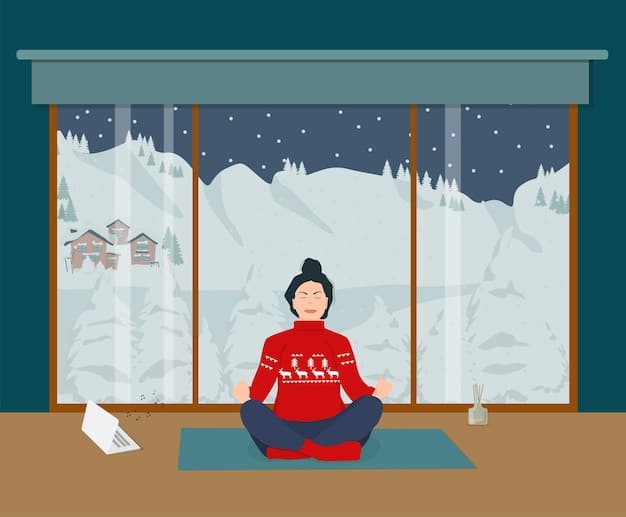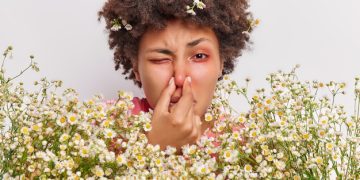Combat Seasonal Affective Disorder: Light Therapy & Solutions for US Residents

Seasonal Affective Disorder (SAD) significantly impacts many US residents due to seasonal light changes, but tailored solutions like light therapy, lifestyle adjustments, and professional support effectively mitigate symptoms, improving quality of life during darker months.
As the days shorten and sunlight becomes a fleeting memory, many in the United States find themselves grappling with a profound shift in mood and energy. This annual phenomenon, known as Seasonal Affective Disorder (SAD), affects millions, transforming vibrant individuals into shadows of their former selves. Understanding SAD, its causes, and, crucially, its effective treatments is the first step toward reclaiming your winter wellness.
Understanding Seasonal Affective Disorder (SAD)
Seasonal Affective Disorder, often referred to as seasonal depression, is more than just the “winter blues.” It’s a type of major depressive disorder that occurs with a regular seasonal pattern, typically beginning in late fall or early winter and remitting in spring or summer. While less common, some individuals experience SAD in the summer months. For US residents, given the varied climates and latitudes, the impact can differ, but the underlying mechanisms often involve disruptions to the body’s natural circadian rhythm and an imbalance in neurotransmitters like serotonin and melatonin.
The precise cause of SAD isn’t fully understood, but research points to several contributing factors. Reduced sunlight in autumn and winter is thought to disrupt the internal clock (circadian rhythm) that regulates mood, sleep, and hormones. This disruption can lead to a drop in serotonin, a brain chemical that affects mood, and an overproduction of melatonin, a hormone that regulates sleep, leading to lethargy and depressive symptoms.
Recognizing the Symptoms of SAD
Identifying SAD is crucial for seeking timely help. The symptoms can vary in severity but often include a consistent pattern of changes:
- Persistent low mood, sadness, or feeling down most of the day, nearly every day.
- Loss of interest or pleasure in activities once enjoyed.
- Changes in appetite, often craving carbohydrates and leading to weight gain.
- Changes in sleep patterns, typically oversleeping (hypersomnia) and having difficulty waking up.
- Low energy, fatigue, and lethargy.
- Difficulty concentrating.
- Feelings of hopelessness, worthlessness, or guilt.
- Social withdrawal.
It’s important to distinguish SAD from general winter fatigue or other depressive disorders. A key characteristic of SAD is its regular seasonal pattern. If you notice these symptoms recurring year after year during specific seasons, especially winter, it’s worth discussing with a healthcare provider.
The prevalence of SAD tends to be higher in regions with less winter daylight. For residents in northern US states, where winter days are significantly shorter and cloudier, the risk can be elevated. However, even in sunnier climates, the individual susceptibility to light deprivation and circadian rhythm disruption can trigger SAD symptoms.
Light Therapy (Phototherapy): A Cornerstone Treatment
Among the most effective and widely recommended treatments for SAD is light therapy, also known as phototherapy. This involves daily exposure to a special light box that mimics natural outdoor light. The goal is to compensate for the lack of natural sunlight and help reset the body’s circadian rhythm.
Light therapy lamps are significantly brighter than regular indoor lights, typically emitting 10,000 lux of light, which filters harmful UV rays. To be effective, the light needs to reach the eyes indirectly; direct staring into the light source is not recommended. The timing of exposure is also crucial, with morning sessions often yielding the best results, as they mimic the natural sunrise and help suppress melatonin production, promoting wakefulness and elevating mood.
How Light Therapy Works
The mechanism behind light therapy is believed to involve its effect on neurotransmitters and the circadian rhythm. By increasing light exposure, it helps to regulate melatonin production, which can become elevated in individuals with SAD. It also aids in boosting serotonin levels, directly impacting mood regulation. The body interprets this bright light as natural sunlight, signaling the brain to adjust its internal clock and biochemical processes.
- Regulates Melatonin: Light helps suppress melatonin, the hormone that causes drowsiness. Increased evening melatonin in winter can lead to SAD symptoms.
- Boosts Serotonin: Bright light exposure can increase serotonin, a neurotransmitter critical for mood regulation, appetite, and sleep.
- Resets Circadian Rhythm: Exposure to bright light, especially in the morning, helps correct the body’s natural sleep-wake cycle, which can become disrupted in winter.
Choosing the right light therapy device is important. Look for products specifically designed for SAD treatment, certified by regulatory bodies, and providing 10,000 lux of full-spectrum light. While generally safe, it’s advisable to consult a healthcare professional before starting light therapy, especially if you have pre-existing eye conditions or are taking medications that might increase light sensitivity.
For US residents seeking light therapy, many reputable brands offer light boxes available for purchase online or at medical supply stores. Some insurance plans may even cover the cost if prescribed by a physician due to a diagnosed SAD condition. Consistency is key with light therapy; daily use, typically for 20-30 minutes, can lead to noticeable improvements within a few weeks.

Beyond Light Therapy: Holistic Approaches to SAD
While light therapy is highly effective for many, it’s often most beneficial when combined with other strategies. A holistic approach that addresses various aspects of well-being can significantly enhance the ability to combat SAD symptoms and maintain mental health throughout the year.
Lifestyle adjustments play a pivotal role. Regular physical activity, even in the colder months, can serve as a powerful mood booster. Exercise releases endorphins, natural mood elevators, and helps manage stress. Simple activities like taking a brisk walk during daylight hours, even on cloudy days, can contribute to beneficial light exposure and metabolic well-being.
Maximizing Natural Light Exposure
Even without a light box, maximizing natural light exposure is a crucial strategy. Make an effort to spend time outdoors during daylight, particularly in the morning. Keep curtains open and trim tree branches that block sunlight. Arrange your home or workspace to take advantage of natural light. Consider taking short breaks outside, even if it’s just for five to ten minutes, to soak up some rays.
Diet also impacts mood. While comfort foods may be appealing during darker days, a balanced diet rich in fruits, vegetables, lean proteins, and omega-3 fatty acids can support overall brain health. Limiting processed foods, excessive sugar, and caffeine can help stabilize energy levels and mood. Some research suggests that vitamin D deficiency, common in winter due to reduced sun exposure, may exacerbate SAD symptoms, making supplementation a consideration under medical guidance.
Social connection is another vital component. During SAD, there’s a natural tendency to withdraw. Actively counteracting this by maintaining social connections, engaging in hobbies, or joining groups can provide emotional support and a sense of belonging, which are protective factors against depression. Even virtual interactions can provide a sense of connection when in-person meetings are not possible or desirable.
Psychotherapy and Medication: Professional Support for SAD
For some individuals, especially those with severe SAD or those who don’t respond adequately to light therapy and lifestyle changes, professional interventions like psychotherapy or medication may be necessary. These treatments can provide additional support, helping to manage symptoms and improve coping strategies.
Cognitive Behavioral Therapy (CBT) has shown particular effectiveness in treating SAD. CBT for SAD, sometimes called CBT-SAD, helps individuals identify and change negative thought patterns and behaviors contributing to their seasonal depression. It focuses on developing skills to cope with the changing seasons, such as identifying early warning signs, planning enjoyable activities during winter, and improving sleep hygiene.
The Role of Antidepressants
Antidepressant medications, particularly selective serotonin reuptake inhibitors (SSRIs), may be prescribed for SAD. SSRIs work by increasing the levels of serotonin in the brain, which can help improve mood. They are often prescribed to be taken before the onset of symptoms and continued throughout the winter months, then gradually tapered off in the spring. Decisions about medication should always be made in consultation with a healthcare provider, considering potential side effects and individual health profiles.
- SSRIs: These medications help balance serotonin levels, a key neurotransmitter affecting mood and well-being.
- Bupropion: Another antidepressant, bupropion, an atypical antidepressant, may also be effective for some individuals with SAD.
- Personalized Treatment: The choice of medication and dosage is highly individualized and determined by a healthcare professional based on a thorough assessment.
A combined approach, integrating light therapy, lifestyle modifications, and professional therapeutic support, often yields the most comprehensive and lasting results. It’s important to remember that SAD is a real and treatable medical condition. Seeking help is a sign of strength and a crucial step toward reclaiming your well-being during the darker months.
For US residents, access to mental health services varies, but many insurers cover therapy and medication. Online therapy platforms have also made professional support more accessible, reducing barriers for those in rural areas or with mobility challenges.
Nutritional Strategies and Supplements for Mood Support
Beyond the primary treatments, dietary choices and select supplements can play a supportive role in managing SAD symptoms. While these are not standalone cures, they contribute to overall well-being and might help mitigate some of the biological imbalances associated with seasonal mood changes.
Emphasis on a balanced diet continues to be crucial. Foods rich in omega-3 fatty acids, found in fatty fish like salmon and mackerel, flaxseeds, and walnuts, are known to support brain health and have been linked to improved mood in some studies. Complex carbohydrates, rather than simple sugars, provide sustained energy and can help regulate blood sugar levels, preventing the energy crashes that sometimes accompany SAD.
The Importance of Vitamin D
Vitamin D deficiency is particularly common in the US during winter months due to reduced sun exposure. Vitamin D plays a role in serotonin production and overall brain function. While dietary sources are limited, supplementation is a viable option for many. It’s crucial to have your vitamin D levels checked by a doctor before starting high-dose supplementation, as excessive intake can be harmful.
Other nutrients and supplements sometimes discussed in the context of mood include B vitamins, magnesium, and probiotics. B vitamins are essential for neurotransmitter synthesis. Magnesium is involved in numerous biochemical reactions, including some related to mood. Gut health, supported by probiotics, is increasingly linked to brain health through the gut-brain axis, influencing everything from mood to stress response.
However, the efficacy of these supplements specifically for SAD varies, and research is ongoing. Always consult with a healthcare professional before adding new supplements to your regimen, especially if you are taking other medications, to avoid potential interactions or adverse effects. A nutritionist or registered dietitian can also provide personalized dietary advice tailored to your needs and help identify potential deficiencies.
Focusing on nutrient-dense foods and considering targeted supplementation under medical guidance can be a valuable complement to other SAD management strategies, providing your body with the building blocks it needs for optimal brain function and mood regulation.

Mindfulness and Stress Management Techniques
The psychological toll of SAD extends beyond simply feeling sad; it often involves increased stress and anxiety. Incorporating mindfulness and various stress management techniques into your daily routine can significantly enhance coping mechanisms and reduce the impact of seasonal shifts on mental health.
Mindfulness practices, such as meditation and deep breathing exercises, teach you to observe your thoughts and feelings without judgment. This can be particularly beneficial for SAD, as it helps break the cycle of negative rumination and promotes a sense of calm. Regular practice can improve emotional regulation, reduce perceived stress, and foster a greater sense of well-being.
Stress Reduction Strategies
Identifying and actively managing stressors in your life is also crucial. During winter, increased demands, holiday stress, or even just the gloomy weather can amplify feelings of overwhelm. Developing healthy coping strategies can make a significant difference:
- Regular Breaks: Schedule short breaks throughout your day to decompress, whether it’s stretching, listening to music, or stepping outside.
- Hobbies and Interests: Engage in activities you enjoy. Hobbies can be a form of active relaxation and provide a positive outlet for energy.
- Sleep Hygiene: Prioritize consistent sleep schedules, create a relaxing bedtime routine, and ensure your sleep environment is conducive to rest.
- Time Management: Effective time management can reduce feelings of being overwhelmed, allowing for dedicated periods of rest and self-care.
These techniques help build resilience against the psychological impact of SAD. By consciously choosing to engage in activities that promote relaxation and mental clarity, individuals can regain a sense of control over their mood and energy levels, even when external conditions are challenging. For US residents, resources for mindfulness and stress management are widely available, from online apps and guided meditations to local community classes and workshops.
The integration of these practices with other SAD treatments creates a robust, multi-faceted approach, addressing both the physiological and psychological dimensions of the disorder. It’s about empowering yourself with tools to navigate the seasonal changes with greater ease and resilience.
Preventative Measures and Planning for Seasonal Well-being
A proactive approach to SAD can significantly reduce its impact. Instead of waiting for symptoms to emerge, residents in the US can begin implementing preventative measures in late summer or early fall, preparing their bodies and minds for the darker months ahead. This involves creating a personalized “SAD prevention plan” that incorporates various strategies.
One key aspect of prevention is consistency with light exposure. Even before the noticeable shortening of days, consider starting light therapy sessions intermittently or increasing outdoor time during peak daylight hours. This can help “prime” your system and make the transition smoother, potentially lessening the severity of symptoms when they typically manifest.
Building a Winter Wellness Routine
Establishing and sticking to a consistent routine is paramount. Maintain a regular sleep schedule, even on weekends, to support your circadian rhythm. Plan for regular physical activity, recognizing that outdoor options might diminish. Consider indoor alternatives like gym memberships, home workouts, or joining a dance class.
- Start Early: Begin light therapy and lifestyle adjustments in late summer/early fall, before symptoms typically appear.
- Consistent Sleep: Maintain a fixed sleep-wake schedule to support your body’s natural rhythms.
- Scheduled Activities: Plan enjoyable indoor activities and social interactions to look forward to during winter.
- Professional Check-ins: Maintain communication with your healthcare provider to adjust your plan as needed.
Proactive mental health support is also a valuable preventative measure. If you have a history of SAD, scheduling check-ins with a therapist or psychiatrist before symptoms start can provide a safety net. This allows for early intervention, adjusting medication or therapy protocols as necessary, before symptoms become debilitating.
Stocking up on helpful resources, such as a high-quality light therapy lamp or books on SAD management, can also be part of your preparedness plan. Creating a comforting home environment with warm lighting and inviting spaces can also contribute positively to your mood as the weather outside turns colder. By taking these steps, US residents can transform what used to be a challenging season into a period of proactive self-care and resilience.
Such preparation is not just about avoiding distress; it’s about fostering an attitude of agency and empowerment over your well-being, demonstrating that seasonal changes can be managed with foresight and strategic planning.
| Key Aspect | Brief Description |
|---|---|
| 💡 Light Therapy | Daily exposure to bright light (10,000 lux) to mimic natural sun and regulate mood. |
| 🧘🏽♀️ Holistic Care | Combines exercise, balanced diet, social connection, and natural light exposure. |
| 🧠 Professional Help | Psychotherapy (CBT-SAD) and antidepressants (SSRIs) considered for severe cases. |
| 🛡️ Prevention | Proactive planning, consistent routines, and early intervention to minimize seasonal impact. |
Frequently Asked Questions about SAD Solutions
▼
10,000 lux is a measure of light intensity, significantly brighter than typical indoor lighting (which is usually around 500 lux). This intensity is crucial for light therapy because it has been clinically shown to be effective in suppressing melatonin and re-regulating the circadian rhythm, which are key to alleviating SAD symptoms.
▼
No, tanning beds and sunlamps are not suitable substitutes. They emit harmful UV radiation that can damage your skin and eyes, and they are not designed to deliver the specific, safe light spectrum and intensity required for SAD treatment. Always use a light box specifically designed for SAD therapy, which filters out UV light.
▼
Many individuals begin to notice improvements in their mood and energy levels within a few days to two weeks of consistent, daily light therapy use. However, full benefits may take up to four weeks to become apparent. Consistency is essential for effective treatment outcomes.
▼
Light therapy is generally safe, but some people may experience mild side effects, especially when first starting. These can include eye strain, headaches, nausea, or irritability. Adjusting the distance from the light or the duration of sessions can often mitigate these symptoms. Consult your doctor if side effects persist or are severe.
▼
If your SAD symptoms are severe, significantly impair your daily functioning, or don’t improve with light therapy and lifestyle adjustments, it’s crucial to seek professional help. A doctor or mental health professional can provide a diagnosis, discuss medication options, or recommend psychotherapy like CBT to address underlying issues.
Empowering Your Winter Wellness Journey
Navigating the challenges of Seasonal Affective Disorder for US residents requires a blend of scientific understanding, proactive planning, and compassionate self-care. From the powerful efficacy of light therapy to the subtle yet profound impacts of lifestyle adjustments, nutritional support, and mindfulness, a multifaceted approach offers the most robust pathway to sustained well-being during the darker months. By recognizing SAD not as an inevitable winter fate but as a treatable condition, individuals can reclaim their energy, mood, and zest for life. The journey begins with awareness and progresses with intentional choices, paving the way for a brighter, more balanced experience, no matter the season. Remember, embracing these solutions is an act of empowerment, fostering resilience and ensuring that the internal light within you continues to shine.





